Overview
At first sight, iguanas look like they have crawled straight out of a prehistoric era. With their spiny backs, scaly bodies, and long whipping tails, these amazing creatures almost resemble a little dinosaur!
But have no fear, iguanas aren’t dangerous meat-eaters. Instead, they’re pretty chilled-out vegetarians that love to relax in the sunshine. Unfortunately, these cool animals are at risk from habitat loss and predation, causing them to encroach into some urban areas where they are killed as pests.
In this iguana animal fact sheet, we tell you everything there is to know about these scaly sunbathers and why we should do everything we can to protect them.
What Is an Iguana?
Iguanas are a large type of lizard. They can grow from anywhere between 1.2 m to 2.0 m long, including their impressive tails.
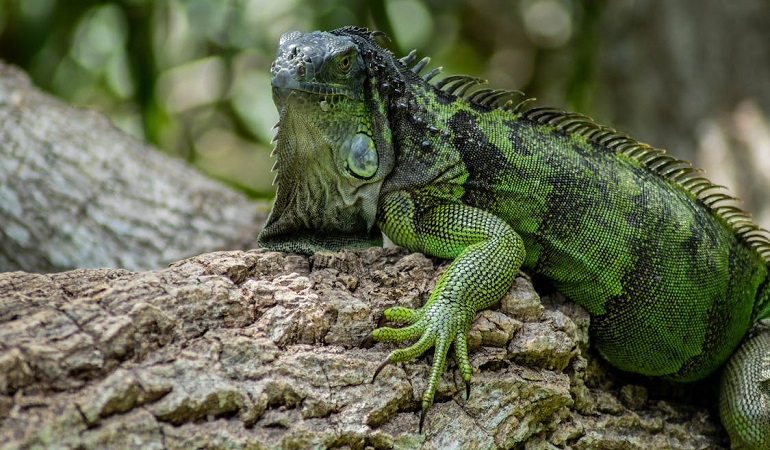
What Does an Iguana Look Like?
Iguanas are very cool-looking animals. They have long bodies and range in color from green to dark gray, deep green, bright orange, or pale brown, depending on the species.
They have flexible spines along their backs, and their bodies are covered in scales. Underneath their jaws is a membrane that hangs down. They have a dewlap, as well as a row of long scales that run from their neck all the way down to their tail.
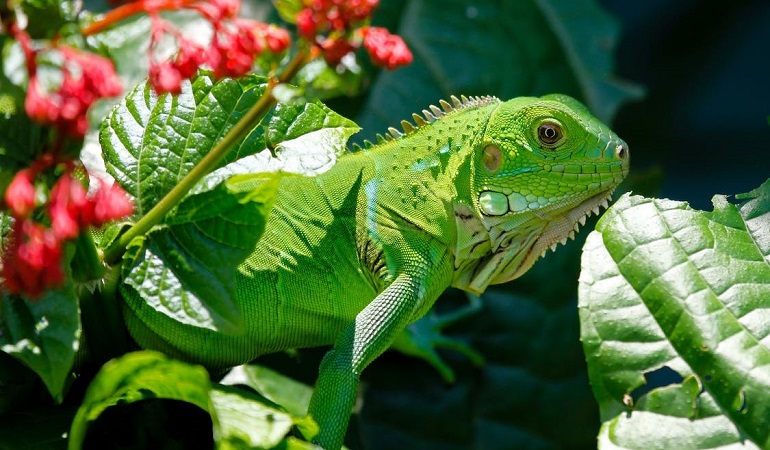
An Iguana’s scales can vary across their bodies. Some areas, such as the neck, have small, overlapping scales combined with round tuberculate scales. On their sides, the scales are thicker and densely packed. They have a large scale on their cheeks which is called the “subtympanic shield.”
Their tails are very powerful and are often half the length of their bodies!
Iguana Anatomy and Physiology
Iguanas are incredible reptiles that have interesting biology and lifestyle habits. Here are some of their most amazing features.
Iguana Parietal Eye
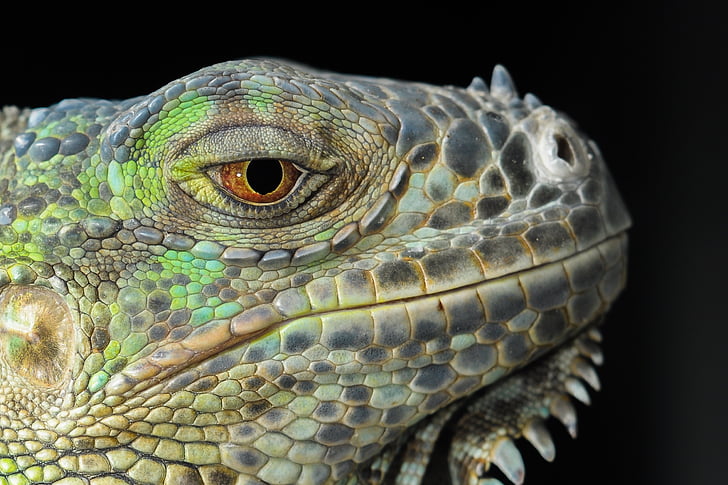
Iguanas are one of many lizard species with a unique anatomy called the “parietal eye.”
Toward the rear of their heads is a pale-colored scale, which denotes the location of this special organ. The parietal eye is super sensitive to fluctuations in light – sending signals to the pineal gland in the iguanas’ brain.
This allows the iguana to sense the transition in ambient light between dawn, daytime, dusk, and night. It helps this clever lizard tell the time so they know when to wake up, forage, and settle down to sleep.
Skull Morphology
Iguanas are herbivorous creatures. This means that they spend their time foraging for vegetation and fruits to fill their tummies.
The plant matter is pretty tough compared to the flesh, so relative to their size, iguanas need to have a higher bite force than meat-eating animals. They have razor-sharp teeth and a specially-adapted skull to help them achieve this.
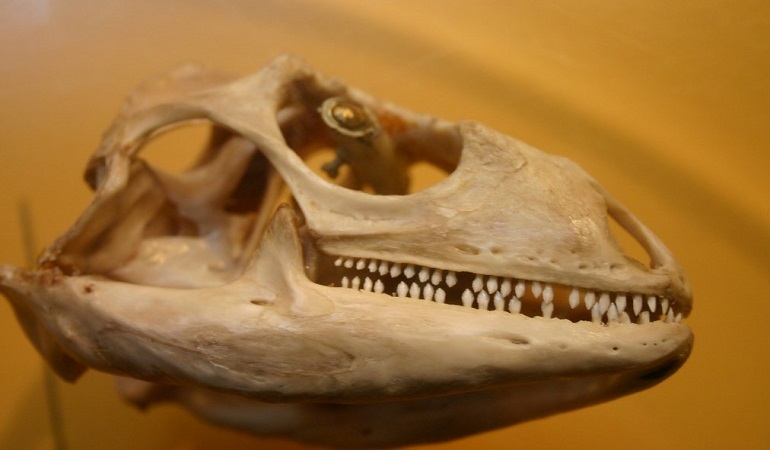
Their skull is taller and wider and has shorter snout compared to carnivorous animals. This modification gives the skull additional strength and provides a greater surface area for extra jaw muscles.
When all of these adaptations are combined, their skull can withstand the much stronger bite force required to eat tough materials.
Reproduction
Unlike mammals, male iguanas have two penises! This is actually quite common in reptiles.
Experts believe this is because each penis is linked to one testis. As only one side can be used at a time, they have another as a backup, just in case one of their testis runs out of sperm.
This unique mating style means they can continue mating and increase their chances of reproducing.
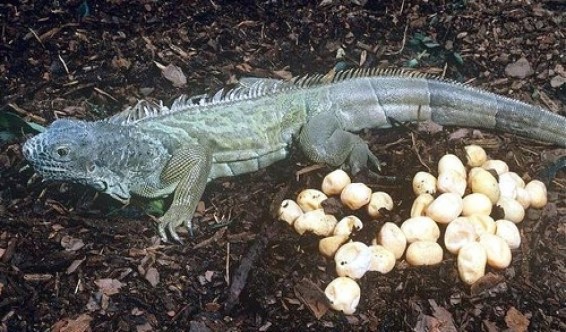
When copulating, the male iguana inserts one of his penises into the “cloacal vent” of the female. His partner can also store sperm from previous mates for years, so she can still fertilize her eggs in the future if she doesn’t find a male in her territory.
Mating
Iguanas tend to be pretty promiscuous animals. If possible, they will mate with several partners during the dry season. Mating in this season means that the eggs will hatch during the wet season when there’s plenty of food to support their offspring.
Female iguanas manage large territories. Within their territory, they will build several nests. All the males in her area will engage in sexual competition for her, and if they are the winner, they mark the territory by secreting a pheromone from the pores on their hind limbs.
To swoon his partner, the male iguana performs head bobbing, nuzzles and bites her neck, displays his dewlap, and sometimes changes his color. If she likes his advances, the female will choose him and allow him to mate with her.
The male will then climb onto her back and straddle her. He holds her in place by biting her shoulder. This can sometimes injure the female, often leaving a scar.
Once mating is completed, the female grows a number of eggs for about 65 days before laying them. She will then keep them warm during a 3-4 month incubation period before they hatch.
Is Iguana Herbivorous?
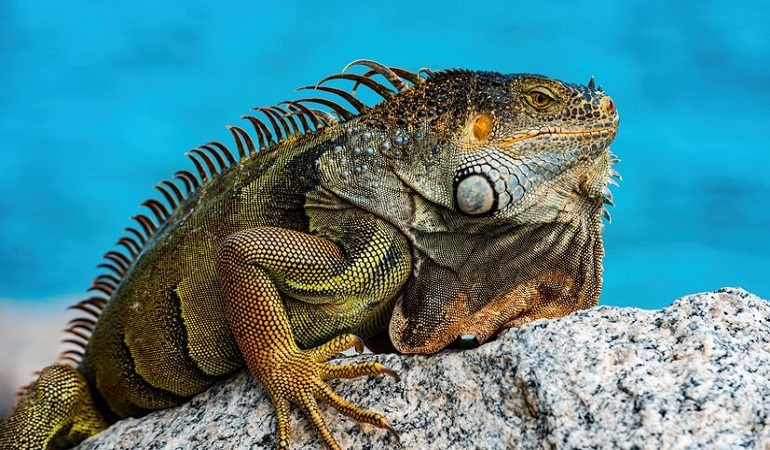
Most iguanas are herbivores. This means they will only eat plant matter such as fruit, grasses, flower buds, and leaves. Marine-dwelling iguanas will eat seaweed or algae that they scrape from rocks underwater.
Domesticated iguanas may also eat insects such as crickets, worms, baby mice, fruit, and vegetables.
Taxonomic Hierarchy of Iguana
There are 35 known species of iguana.
They are in the Animalia kingdom, the Reptilia class, and the family Iguanidae.
The most well-known species are the Green iguana, Fiji banded iguana, Galapagos marine iguana, Galapagos pink land iguana, the common desert iguana, and the Utila spiny-tailed iguana.
Iguana Meat as Food
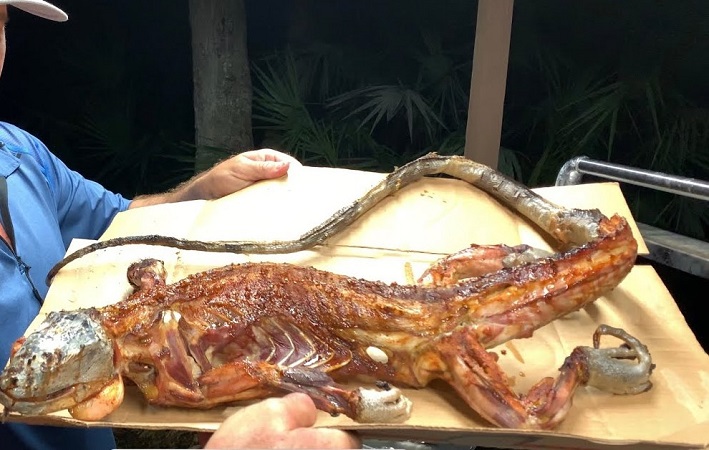
People have long eaten iguana meat in cultures of Southern Mexico and Central America. Iguana meat is also legal in the USA and other countries; however, its importation is restricted by CITES regulations.
In the above regions, both Green iguana and Black iguana meat is eaten – although Green iguana tends to be more popular. The meat is commonly eaten in stews, tacos, birria, and flautas.
People living in South Florida began cooking and eating iguanas after they were encouraged to kill them to control the population. They are trapped in the everglades and are also farmed for their meat in some regions.
In the USA, iguana meat for human consumption must come with proof that the animal was raised and fed in good conditions and ethically killed with no suffering. All meat must be approved by the FDA before it can be sold as food.
Where Do Iguanas Live?
Iguanas prefer to live in tropical, warm areas such as dense rainforests in Central and South America. These habitats have lots of trees and vegetation that provide shelter and food. The warm climate is very important, as iguanas are cold-blooded and rely on surrounding temperatures to stay warm.
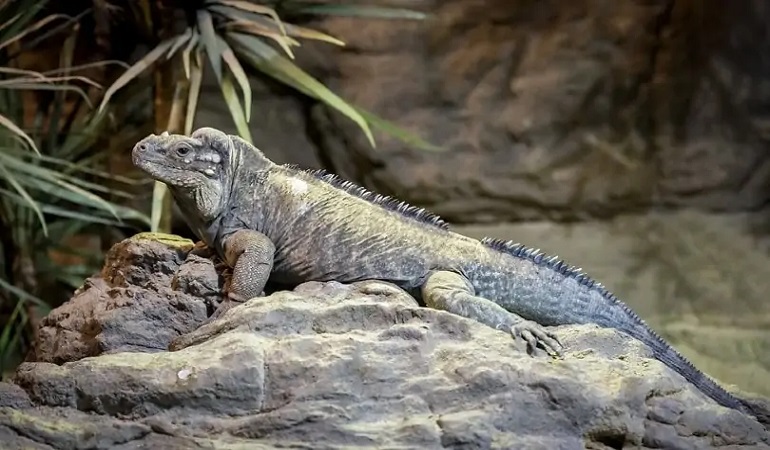
As an arboreal species, Green iguanas spend most of their time up in the canopy. However, their habitat also includes water, and they are very comfortable swimmers. They will often leap into the water to escape predators and can survive falls of more than 40 feet.
Some iguana species live in and around the ocean, such as the Marine iguana. They are a distinct species found around Caribbean islands.
Iguanas Behavior
Iguanas are very sociable animals that are happy to eat and live in proximity to each other. Dominant male behavior is particularly territorial, though, and males compete with others that try to take over their area.
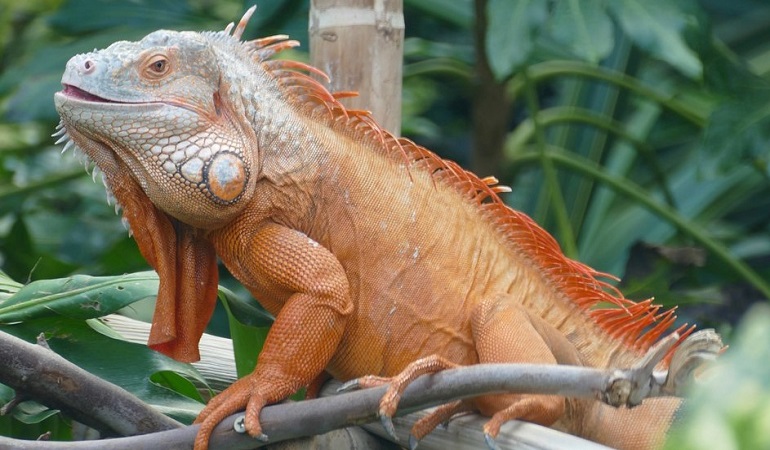
Not all male iguanas are dominant, those that are submissive usually have broken spines along their backs – the evidence of losing fights in the past.
Because iguanas don’t hunt for their meals, they are very relaxed creatures. Most of the time, they will lay around sunbathing, occasionally getting up to locate food.
Iguanas Family Life
Most adult iguanas will live alone. When they are juveniles, the young iguanas will live with their mother and father in the same family group. Green iguana males will protect the females and young from predators. The Green iguana is the only reptile species to have this family unit.
These herbivorous lizards use all kinds of body language and visual signals to communicate with each other. They will make noises, bob their heads, twitch their tails, change their posture and flick their tongues.
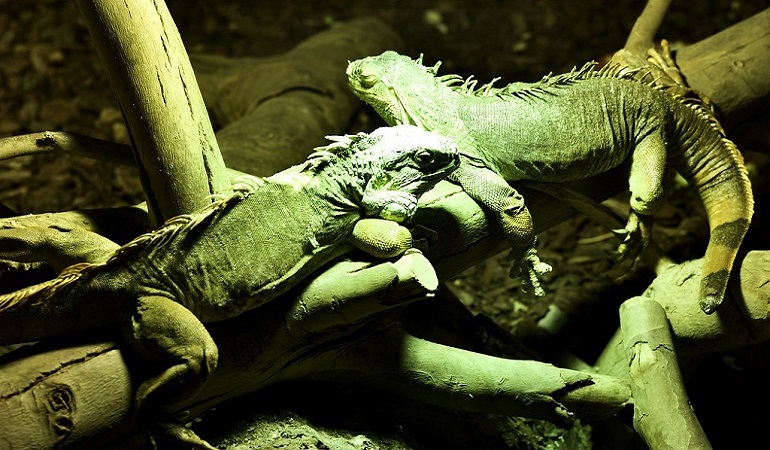
When posturing, two individuals will face off against each other, stiffening their bodies to appear strong and dominant. They may grunt, click and hiss at each other to encourage one party to back down. Sometimes, they will also vocalize like this to warn other iguanas about predators.
Using various communications, iguanas can portray fear, anger, stress, and affection to other individuals.
When they are unhappy, they will keep their eyes open, tense up their bodies, and keep their spines rigid. They will close their eyes and relax their spines when they are more chilled.
Can Iguanas Be Kept at the Zoo?
Yes, iguanas are often kept at zoos in reptile houses. Zookeepers should ensure that they have the correct temperature and habitat inside their enclosures so captive iguanas can live happy, healthy lives.
Keeping iguanas in zoos is a great way to educate people about these beautiful and unique animals. San Diego zoo has a long history of keeping iguana species. In fact, San Diego zoo now cares for the biggest and most successful colony of Fiji Island, Banded iguanas outside of their native island.
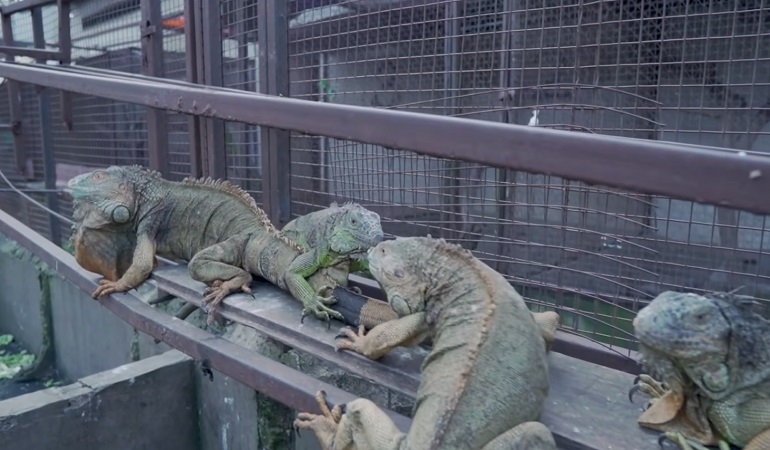
Iguanas Captivity as Pet
Green iguanas have been kept as pets for a long time. However, nowadays, due to the complexity of their care and regulations on the pet trade, fewer people are choosing to keep them.
If you are an experienced reptile keeper, these exotic animals can be very interesting pets. They are intelligent and can be a fun and affectionate companion. Some owners have been able to train their iguana to use the potty and perform tricks.
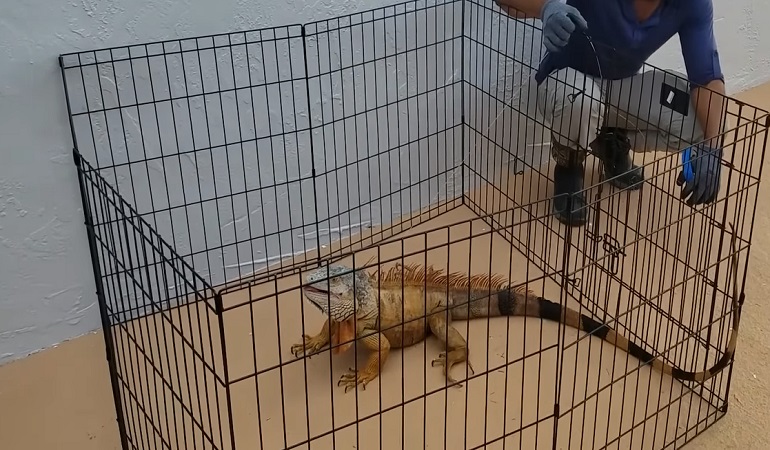
However, these animals can grow up to 6 feet long as adults. Therefore, they require a very large enclosure to move around inside, as well as an appropriate amount of outdoor time for their well-being. They can also live more than 20 years if well cared for.
Predators of Iguana
Whether they are up in the trees, on the ground, or swimming in the water, iguanas have many predators in the wild.
Birds of prey are one of their leading predators. Many birds, such as eagles, owls, and hawks, will kill and eat fully-grown iguanas and take their eggs.
Some herons and waterfowl will also prey on marine iguanas if they have the opportunity. Marine iguanas are the most vulnerable to bird attacks when they are young.
Crocodiles and alligators will also kill and eat iguanas. However, iguanas are known to eat crocodile eggs, too. Therefore, some experts have theorized that crocodiles and alligators kill iguanas as a defensive mechanism rather than purely for food.
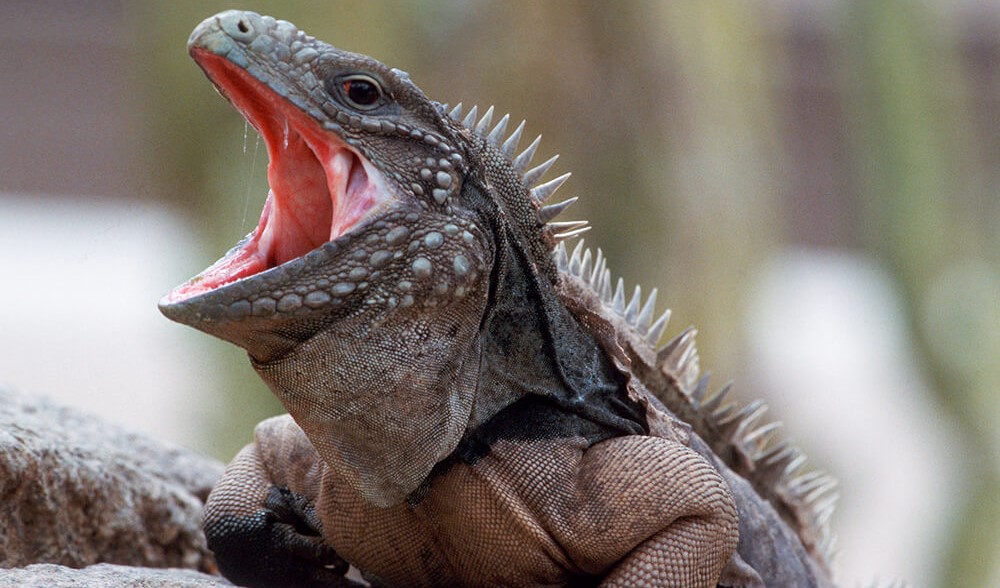
Marine iguanas in the ocean are at risk of predation from large carnivorous fish and sharks. Tiger sharks will often kill and eat iguanas if given the opportunity.
Snakes are also serious predators of Green iguanas and Desert iguanas. Venomous snakes frequently kill and eat this lizard. Boa constrictors will feed on them too. Sometimes, other reptiles, such as ground-dwelling large lizards, will prey on a baby iguana.
Most mammals do not predate iguanas, but domestic or urban animals are known to kill them. Dogs, rats, cats, and raccoons will attack iguanas in built-up environments. Humans also kill iguanas, whether for pest control or for their meat.
Defensive Adaptations of Iguana
Iguanas may be hunted by many different animals, but they have plenty of defenses, too. First of all, they have a very strong and powerful tail, often making up half their body length.
If attacked, an iguana can thrash and whip their tail to defend itself. Should they hit their adversary with full force, the strike can break bones. Some iguana owners have been injured by their pets in this way.
Their tail is not only strong, but it is also sharp too. A whipping iguana tail can slash open the skin of a predator, causing pain and giving the iguana a chance to escape.
Sometimes, an iguana will detach its tail as a distraction mechanism. The loose tail will continue to thrash around on the floor, taking the predators’ attention away from the individual it used to belong to.
This gives the iguana an opportunity to run away. It will grow back eventually, but it may be a bit shorter and darker than it was originally.
Alongside their tails, iguanas also have sharp spines, teeth, and claws to fight with. Their jaws are very strong, thanks to their specially-adapted skulls, so they can give a nasty bite when needed.
Iguanas have plenty of weapons to defend themselves with, but they can also make a pretty speedy getaway when needed. In fact, the spiny-tailed iguana is the fastest reptile on record, capable of running up to 21 miles an hour!
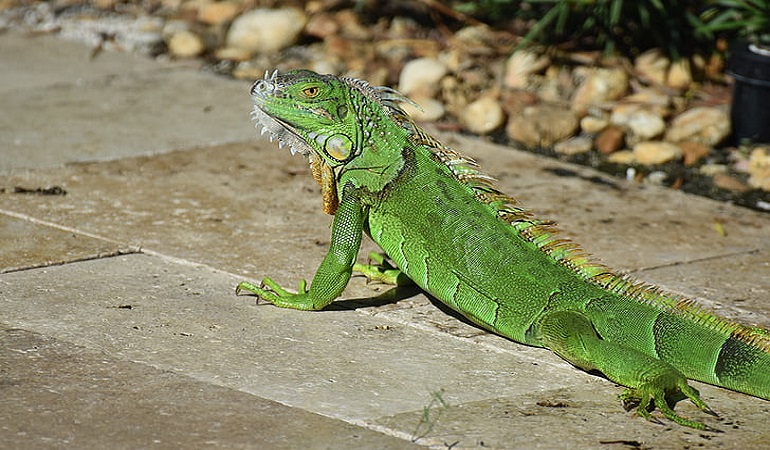
Conservation Status of Iguanas
The International Union for Conservation of Nature (IUCN) has designated some iguana species as among the most endangered species on Earth.
The wild population of iguanas is falling fast. This is a result of habitat destruction and predation.
The Galapagos pink land iguana is classified as critically endangered. In 2012, there was only one small population of 192 adult individuals left. They all existed within a small area of 25 square kilometers.
The Utila spiny-tail iguana is also critically endangered. There are believed to be less than 5 thousand of them left on their native Utila island in Honduras.
Many species of iguana are under threat. Hopefully, conservation education programs will be able to help populations recover.
FAQs
Is Iguana a Lizard?
Yes, iguanas are a type of lizard. In fact, they are one of the largest lizards in the world. Like other lizards, they are cold-blooded and lay eggs.
Can Iguanas Hurt You?
Yes, iguanas are very capable of hurting you, but it’s quite rare for them to be aggressive unless threatened. Iguanas are pretty relaxed animals, so while they have been known to bite people, it’s almost always in self-defense.
Are Iguanas Friendly?
Iguanas are not friendly to humans in the wild. However, domesticated iguanas can be quite affectionate to their owners. In their natural habitat, an iguana may be aggressive towards people if it feels cornered or in danger.
Can I Remove Iguanas Easily?
Due to a reduction in natural resources, this species will commonly encroach onto people’s property in urban areas, especially in parts of Florida. The best way to remove iguanas is to trap them and release them. Do not kill them or hire pest control to dispatch them for you.
There are many DIY traps that you can make at home to catch and remove common Green iguanas. However, you should check them frequently and be careful not to use them in areas where you could accidentally capture a neighbor’s pet!
Should you manage to catch one of these lizards, you should feed it every 24 hours, provide water and shade, and contact professionals. Wait for the authorities to collect the iguana, do not simply release it elsewhere.
Can Iguanas Swim Easily?
Iguanas are excellent swimmers but much faster on land than in water. They can swim for an extended time, so they can travel long distances if needed.
Iguanas will often leap into the water to escape predators, while Marine iguana species will hold their breath and dive down to forage beneath the surface.
Is Iguana a Reptile?
Yes, iguanas are reptiles in the taxonomic class of reptilia.
Conclusion
Iguanas are incredibly unique creatures that deserve to be protected. With their special skulls, parietal eye, and detachable tails, these animals are specially designed to be masters of their habitat and evade danger.
However, with the pressures of urbanization and predation, the population numbers of some iguana species are rapidly decreasing. Many species are now endangered. We hope that with a combination of education and conservation, this remarkable reptile can have a bright future.
Have you ever seen a wild iguana or kept one as a pet? Let us know in the comments below!


